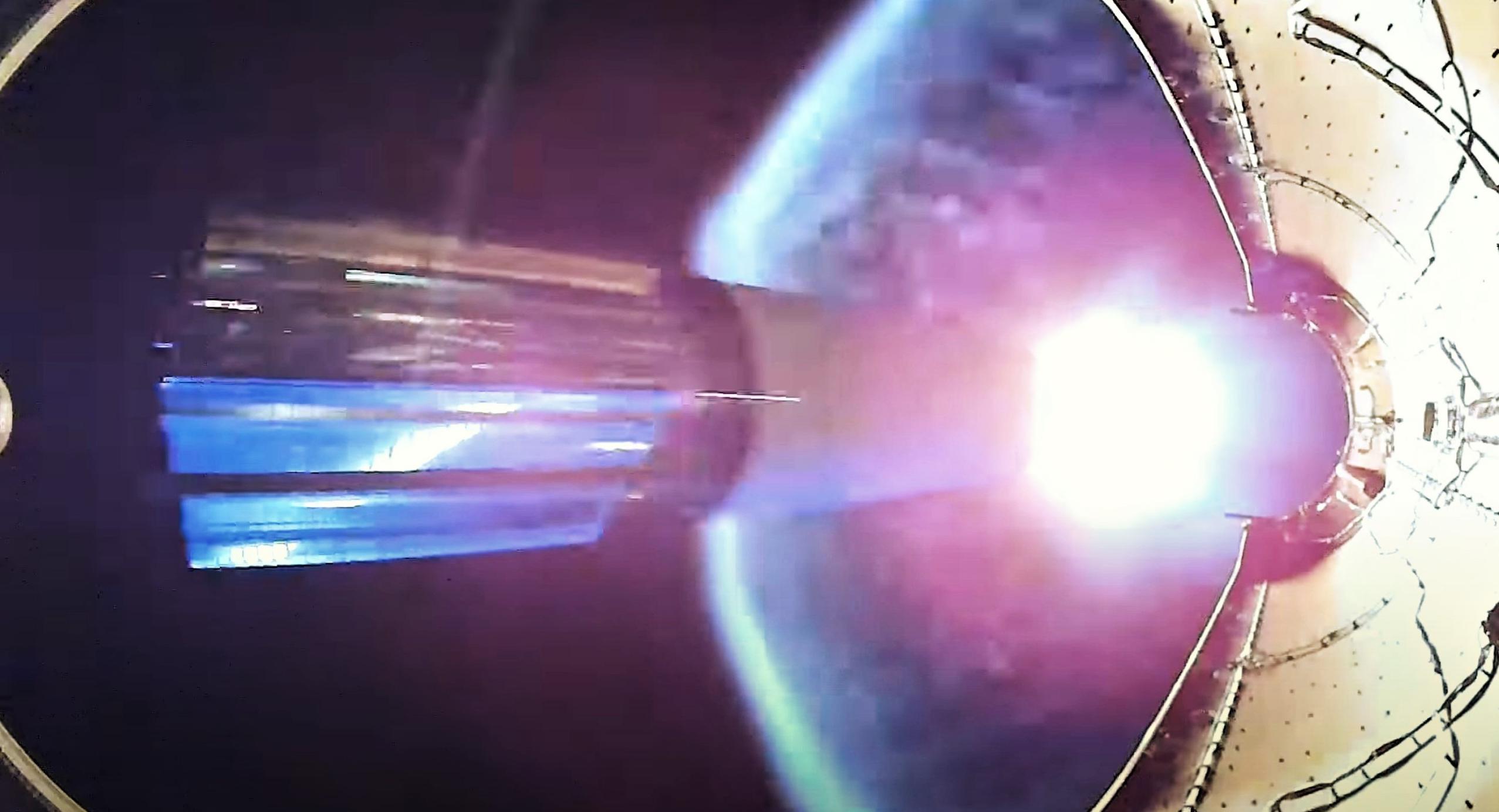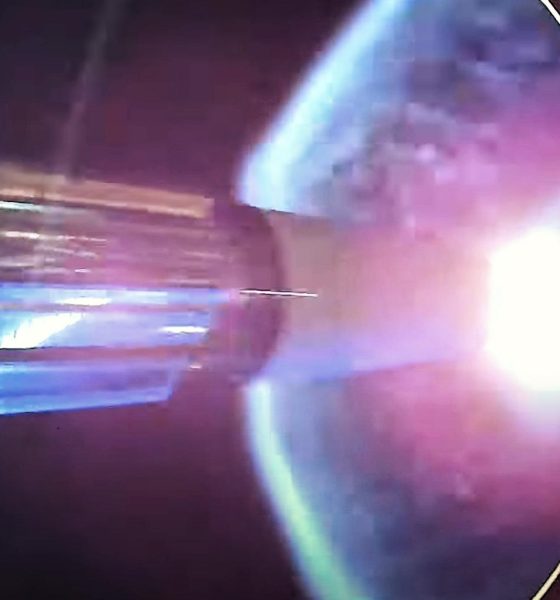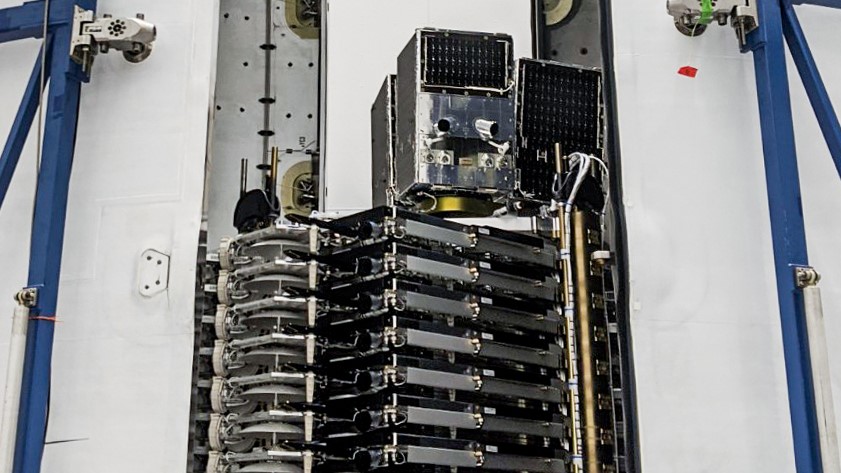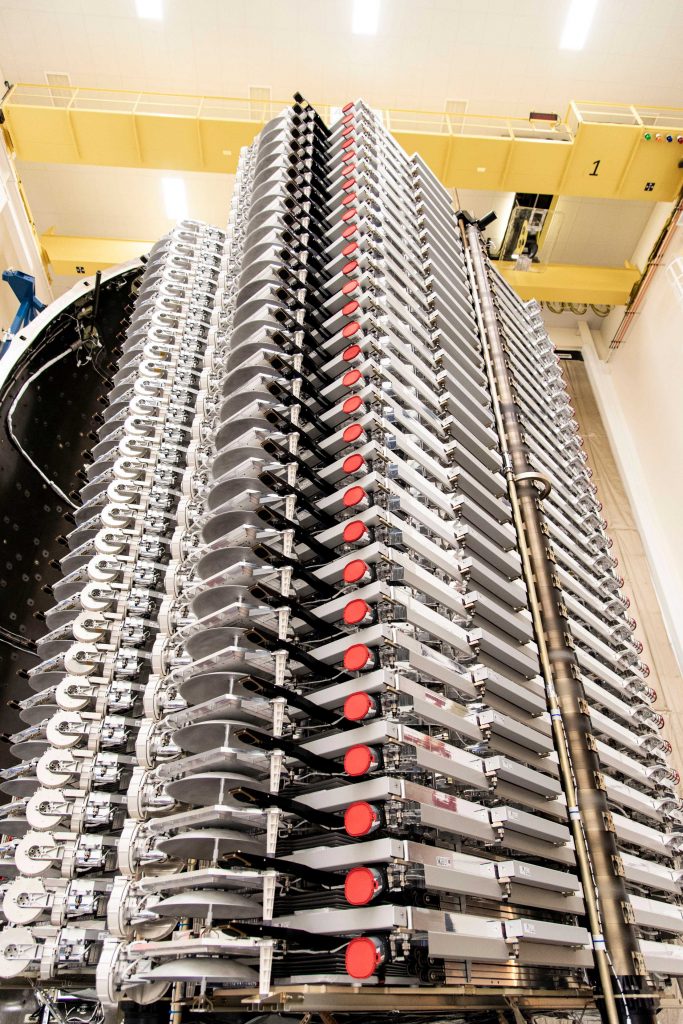

News
Here’s what SpaceX’s first Starlink satellite rideshare mission looks like [photo]
By way of customer Planet, SpaceX has published the first view of its inaugural Starlink satellite rideshare mission, revealing three mini fridge-sized Earth imaging satellites perched on a stack of dozens of Starlink spacecraft.
Scheduled to launch no earlier than (NET) 5:21 am (09:21 UTC) on June 13th, SpaceX’s eighth launch of Starlink v1.0 satellites (Starlink V1 L8) could usher in a revolutionary new way for smallsat operators to get their spacecraft in orbit. The company’s first Starlink rideshare customer has become a vocal supporter in the days before the first launch, praising unprecedentedly low launch costs SpaceX is able to offer. In fact, executives of Planet – now the world’s second most prolific satellite launcher after SpaceX – were so surprised at the prices the launch company was charging that they “could not believe what [they] were looking at”.
To account for the mass added by three Planet SkySats (~350 kg or 770 lb), SpaceX revealed earlier today that it had removed two Starlink satellites – each weighing ~260 kg (570 lb) – from the original stack of 60 spacecraft. Aside from confirming that Falcon 9 is balancing at the very edge of its performance envelope to launch ~16 metric tons (~35,000 lb) of satellites while still enabling booster recovery, the removal of two Starlink satellites to make way for rideshare payloads hints at an incredible level of flexibility available to SpaceX.

For customers of the fledgling small satellite rideshare program interested in procuring launch services directly, Planet’s SkySats are almost perfectly sized to extract the most bang for the buck from SpaceX’s current pricing system. Planet likely spent a bit more to have SpaceX build it a custom adapter and deployment mechanism for two launches, but the company’s launch costs for six SkySats – split between two June 2020 Starlink missions – could be as low as $6 million based on SpaceX’s own calculator. Due to the general secrecy of launch prices, it’s hard to accurately compare, but Planet would have had to pay upwards of $40 million – almost seven times as much – to launch six SkySats on dedicated Rocket Lab Electron rockets.

In return for $5-30+ million dollars in savings, Planet’s six new SkySats will have to work to raise their orbits from around 300 to 450 kilometers (190-280 mi) after deploying from SpaceX’s Starlink satellite stack. That work will expend a significant portion of their propellant reserves, likely cutting several months (up to several years) off of their operational lifespans. Believed to cost around $3-5 million each, however, the money Planet has saved by launching SkySats with SpaceX could potentially pay for an entirely new batch of six more satellites (or more).
With cost savings like that at hand, it’s no wonder that Planet’s Mike Safyan – Vice President of Launch – described SpaceX’s Starlink rideshare program as “incredibly competitive” and “one of the more significant programs for the smallsat industry”. Having overseen the launch of hundreds of Planet’s Dove and SkySat satellites over the last nine years, it would be hard to find a more qualified industry voice on the subject. Indeed, the rest of the smallsat industry is also responding positively to SpaceX’s new offering, with dozens of commercial spacecraft already assigned to future rideshare launches.

At this point, SpaceX plans to offer rideshare opportunities on Starlink missions every month for the indefinite future, all while charging as little as a $1 million per slot. Thanks to third-party launch services companies like Spaceflight and Exolaunch, much smaller cubesats and nanosats will also have ways to get into orbit on SpaceX rockets for much less than the company’s base price. Meanwhile, scheduled to launch no earlier than June 22nd, SpaceX’s very next Starlink launch – V1 L9 – is expected to include three more Planet SkySats and two similar BlackSky imaging satellites.
If SpaceX can maintain the impressive inertia of its Starlink launch and rideshare efforts, it’s safe to say that the company is going to be a towering presence in the smallsat launch industry for the foreseeable future.
Check out Teslarati’s Marketplace! We offer Tesla accessories, including for the Tesla Cybertruck and Tesla Model 3.

Elon Musk
Elon Musk’s X will start using a Tesla-like software update strategy
The initiative seems designed to accelerate updates to the social media platform, while maintaining maximum transparency.

Elon Musk’s social media platform X will adopt a Tesla-esque approach to software updates for its algorithm.
The initiative seems designed to accelerate updates to the social media platform, while maintaining maximum transparency.
X’s updates to its updates
As per Musk in a post on X, the social media company will be making a new algorithm to determine what organic and advertising posts are recommended to users. These updates would then be repeated every four weeks.
“We will make the new 𝕏 algorithm, including all code used to determine what organic and advertising posts are recommended to users, open source in 7 days. This will be repeated every 4 weeks, with comprehensive developer notes, to help you understand what changed,” Musk wrote in his post.
The initiative somewhat mirrors Tesla’s over-the-air update model, where vehicle software is regularly refined and pushed to users with detailed release notes. This should allow users to better understand the details of X’s every update and foster a healthy feedback loop for the social media platform.
xAI and X
X, formerly Twitter, has been acquired by Elon Musk’s artificial intelligence startup, xAI last year. Since then, xAI has seen a rapid rise in valuation. Following the company’s the company’s upsized $20 billion Series E funding round, estimates now suggest that xAI is worth tens about $230 to $235 billion. That’s several times larger than Tesla when Elon Musk received his controversial 2018 CEO Performance Award.
As per xAI, the Series E funding round attracted a diverse group of investors, including Valor Equity Partners, Stepstone Group, Fidelity Management & Research Company, Qatar Investment Authority, MGX, and Baron Capital Group, among others. Strategic partners NVIDIA and Cisco Investments also continued support for building the world’s largest GPU clusters.
News
Tesla FSD Supervised wins MotorTrend’s Best Driver Assistance Award
The decision marks a notable reversal for the publication from prior years, with judges citing major real-world improvements that pushed Tesla’s latest FSD software ahead of every competing ADAS system.

Tesla’s Full Self-Driving (Supervised) system has been named the best driver-assistance technology on the market, earning top honors at the 2026 MotorTrend Best Tech Awards.
The decision marks a notable reversal for the publication from prior years, with judges citing major real-world improvements that pushed Tesla’s latest FSD software ahead of every competing ADAS system. And it wasn’t even close.
MotorTrend reverses course
MotorTrend awarded Tesla FSD (Supervised) its 2026 Best Tech Driver Assistance title after extensive testing of the latest v14 software. The publication acknowledged that it had previously criticized earlier versions of FSD for erratic behavior and near-miss incidents, ultimately favoring rivals such as GM’s Super Cruise in earlier evaluations.
According to MotorTrend, the newest iteration of FSD resolved many of those shortcomings. Testers said v14 showed far smoother behavior in complex urban scenarios, including unprotected left turns, traffic circles, emergency vehicles, and dense city streets. While the system still requires constant driver supervision, judges concluded that no other advanced driver-assistance system currently matches its breadth of capability.
Unlike rival systems that rely on combinations of cameras, radar, lidar, and mapped highways, Tesla’s FSD operates using a camera-only approach and is capable of driving on city streets, rural roads, and freeways. MotorTrend stated that pure utility, the ability to handle nearly all road types, ultimately separated FSD from competitors like Ford BlueCruise, GM Super Cruise, and BMW’s Highway Assistant.
High cost and high capability
MotorTrend also addressed FSD’s pricing, which remains significantly higher than rival systems. Tesla currently charges $8,000 for a one-time purchase or $99 per month for a subscription, compared with far lower upfront and subscription costs from other automakers. The publication noted that the premium is justified given FSD’s unmatched scope and continuous software evolution.
Safety remained a central focus of the evaluation. While testers reported collision-free operation over thousands of miles, they noted ongoing concerns around FSD’s configurable driving modes, including options that allow aggressive driving and speeds beyond posted limits. MotorTrend emphasized that, like all Level 2 systems, FSD still depends on a fully attentive human driver at all times.
Despite those caveats, the publication concluded that Tesla’s rapid software progress fundamentally reshaped the competitive landscape. For drivers seeking the most capable hands-on driver-assistance system available today, MotorTrend concluded Tesla FSD (Supervised) now stands alone at the top.
News
Elon Musk’s Grokipedia surges to 5.6M articles, almost 79% of English Wikipedia
The explosive growth marks a major milestone for the AI-powered online encyclopedia, which was launched by Elon Musk’s xAI just months ago.

Elon Musk’s Grokipedia has grown to an impressive 5,615,201 articles as of today, closing in on 79% of the English Wikipedia’s current total of 7,119,376 articles.
The explosive growth marks a major milestone for the AI-powered online encyclopedia, which was launched by Elon Musk’s xAI just months ago. Needless to say, it would only be a matter of time before Grokipedia exceeds English Wikipedia in sheer volume.
Grokipedia’s rapid growth
xAI’s vision for Grokipedia emphasizes neutrality, while Grok’s reasoning capabilities allow for fast drafting and fact-checking. When Elon Musk announced the initiative in late September 2025, he noted that Grokipedia would be an improvement to Wikipedia because it would be designed to avoid bias.
At the time, Musk noted that Grokipedia “is a necessary step towards the xAI goal of understanding the Universe.”
Grokipedia was launched in late October, and while xAI was careful to list it only as Version 0.1 at the time, the online encyclopedia immediately earned praise. Wikipedia co-founder Larry Sanger highlighted the project’s innovative approach, noting how it leverages AI to fill knowledge gaps and enable rapid updates. Netizens also observed how Grokipedia tends to present articles in a more objective manner compared to Wikipedia, which is edited by humans.
Elon Musk’s ambitious plans
With 5,615,201 total articles, Grokipedia has now grown to almost 79% of English Wikipedia’s article base. This is incredibly quick, though Grokipedia remains text-only for now. xAI, for its part, has now updated the online encyclopedia’s iteration to v0.2.
Elon Musk has shared bold ideas for Grokipedia, including sending a record of the entire knowledge base to space as part of xAI’s mission to preserve and expand human understanding. At some point, Musk stated that Grokipedia will be renamed to Encyclopedia Galactica, and it will be sent to the cosmos.
“When Grokipedia is good enough (long way to go), we will change the name to Encyclopedia Galactica. It will be an open source distillation of all knowledge, including audio, images and video. Join xAI to help build the sci-fi version of the Library of Alexandria!” Musk wrote, adding in a later post that “Copies will be etched in stone and sent to the Moon, Mars and beyond. This time, it will not be lost.”








